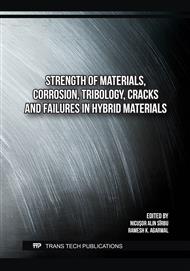[1]
Falcó, O., et al., Modelling and simulation methodology for unidirectional composite laminates in a Virtual Test Lab framework. Composite Structures, 2018. 190: pp.137-159.
DOI: 10.1016/j.compstruct.2018.02.016
Google Scholar
[2]
Laux, T., et al., Modelling damage in multidirectional laminates subjected to multi-axial loading: ply thickness effects and model assessment. Composite Structures, 2021. 266: p.113766.
DOI: 10.1016/j.compstruct.2021.113766
Google Scholar
[3]
Joseph, A.P.K., P. Davidson, and A.M. Waas. Failure analysis of composite multi-bolt joints using intra-inter crack band model (I2CBM).
DOI: 10.2514/6.2018-0977
Google Scholar
[4]
Nguyen, M.H. and A.M. Waas, A novel mode-dependent and probabilistic semi-discrete damage model for progressive failure analysis of composite laminates-Part I: Meshing strategy and mixed-mode law. Composites Part C: Open Access, 2020. 3: p.100073.
DOI: 10.1016/j.jcomc.2020.100073
Google Scholar
[5]
Wang, X., et al., An accurate and easy to implement method for predicting matrix crack and plasticity of composites with an efficient search algorithm for LaRC05 criterion. Composites Part A: Applied Science and Manufacturing, 2020. 131: p.105808.
DOI: 10.1016/j.compositesa.2020.105808
Google Scholar
[6]
Higuchi, R., T. Okabe, and T. Nagashima, Numerical simulation of progressive damage and failure in composite laminates using XFEM/CZM coupled approach. Composites Part A: Applied Science and Manufacturing, 2017. 95: pp.197-207.
DOI: 10.1016/j.compositesa.2016.12.026
Google Scholar
[7]
Liang, Y.-J., J.S. McQuien, and E.V. Iarve, Implementation of the regularized extended finite element method in Abaqus framework for fracture modeling in laminated composites. Engineering Fracture Mechanics, 2020. 230: p.106989.
DOI: 10.1016/j.engfracmech.2020.106989
Google Scholar
[8]
Schapery, R., A theory of mechanical behavior of elastic media with growing damage and other changes in structure. Journal of the Mechanics and Physics of Solids, 1990. 38(2): pp.215-253.
DOI: 10.1016/0022-5096(90)90035-3
Google Scholar
[9]
Liu, N. and P. Chen, A matrix failure criterion independent of empirical parameters for brittle fiber-reinforced composites. Composites Science and Technology, 2024. 255: p.110726.
DOI: 10.1016/j.compscitech.2024.110726
Google Scholar
[10]
Gu, J. and P. Chen, Some modifications of Hashin's failure criteria for unidirectional composite materials. Composite Structures, 2017. 182: pp.143-152.
DOI: 10.1016/j.compstruct.2017.09.011
Google Scholar
[11]
Rots, J.G., B. Belletti, and S. Invernizzi, Robust modeling of RC structures with an "event-by-event" strategy. Engineering Fracture Mechanics, 2008. 75(3-4): pp.590-614.
DOI: 10.1016/j.engfracmech.2007.03.027
Google Scholar
[12]
Higuchi, R., et al., Experimental and numerical study on progressive damage and failure in composite laminates during open-hole compression tests. Composites Part A: Applied Science and Manufacturing, 2021. 145: p.106300.
DOI: 10.1016/j.compositesa.2021.106300
Google Scholar
[13]
Iarve, E.V., D. Mollenhauer, and R. Kim, Theoretical and experimental investigation of stress redistribution in open hole composite laminates due to damage accumulation. Composites Part A: Applied Science and Manufacturing, 2005. 36(2): pp.163-171.
DOI: 10.1016/j.compositesa.2004.06.011
Google Scholar
[14]
Zhang, D., et al., A comparative study on failure mechanisms of open-hole and filled-hole composite laminates: Experiment and numerical simulation. Thin-Walled Structures, 2024. 198: p.111730.
DOI: 10.1016/j.tws.2024.111730
Google Scholar


